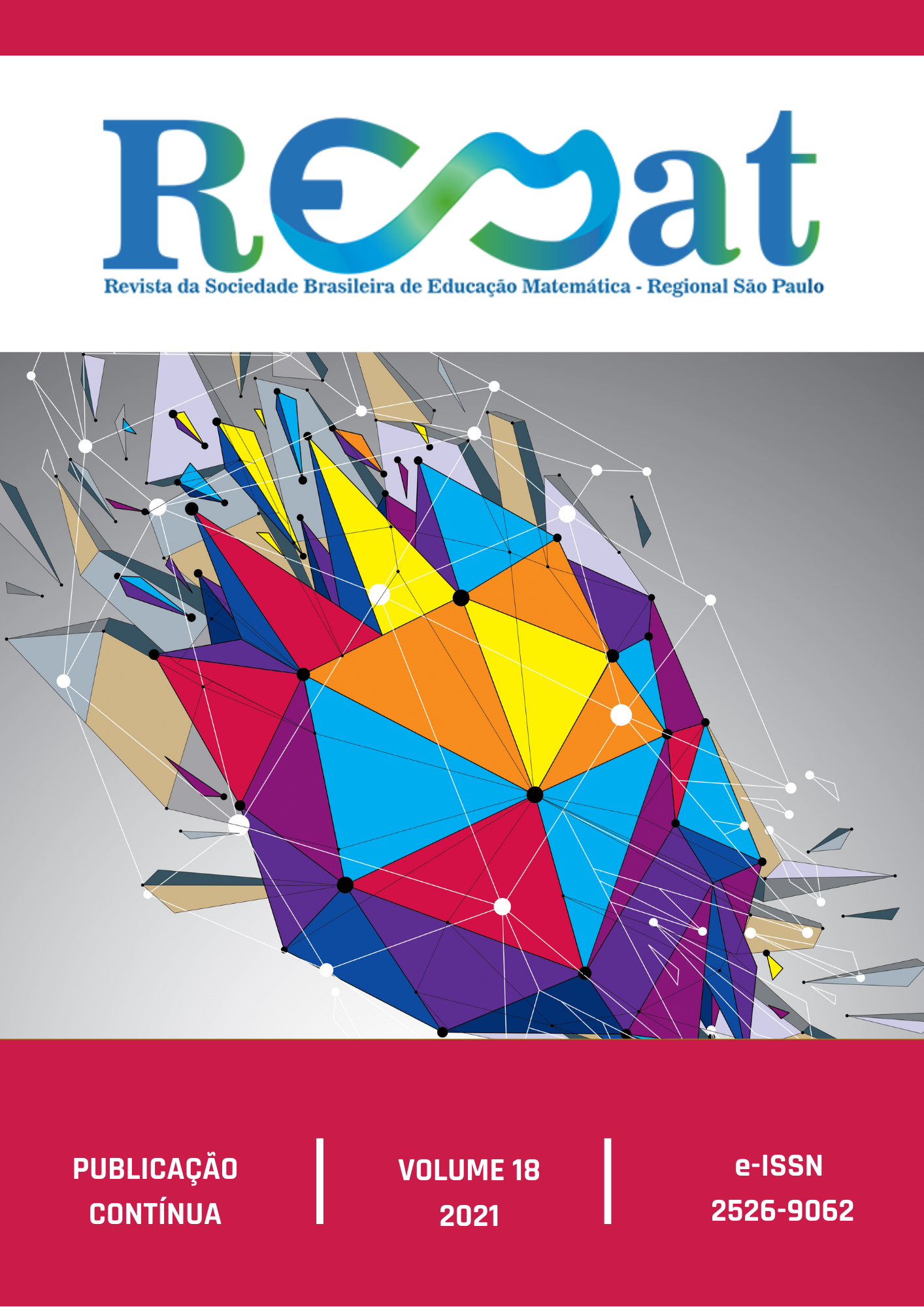Violence in Numbers
DOI:
10.37001/remat25269062v17id485Keywords:
Violence, Statistical Education, Middle SchoolAbstract
This paper aims to address the theme of violence present in the reality in which students from a municipal school in the city of Campinas are inserted. For this, the 9th grade class conducted data collection based on interviews with the other classes of the school that studied in the afternoon. After collection, they tabulated data for each room individually, through personal records and construction of graphs about each question. After completing the individual graphs, the total numbers of each question were collectively generated, with a table and graph. The students were surprised by the indexes stamped, as if they did not feel they belonged to that reality, however, when analyzing the information collected and represented in the form of a graph, they read, making inferences about it, bringing facts from the reality experienced by them, that supported the results. The complete work was exhibited at the “Mostra Cultural” event. After the event, the posters were fixed on the walls of the 9th grade classroom and were used by professionals in other areas for reading, interpreting explicit and implicit information, reading beyond the data. This work enabled students to read the data presented in the Atlas of Violence (2019) and visualize the theme at the state level; and, after applying questionnaires, they were able to see how much violence is present in their lives and in the lives of their colleagues and how it interferes in their decisions.
Downloads
Metrics
References
ARAÚJO, E. S. A aprendizagem e o desenvolvimento profissional docente sob as luzes da perspectiva histórico-cultural. In: ENCONTRO NACIONAL DE DIDÁTICA E PRÁTICA DE ENSINO, 12., 29 de agosto a 1 de setembro de 2004, Curitiba. Anais... Curitiba, 2004. p.3507-3518.
INSTITUTO DE PESQUISA ECONÔMICA APLICADA; FÓRUM BRASILEIRO DE SEGURANÇA PÚBLICA. Atlas da Violência. Brasília; Rio de Janeiro; São Paulo: Instituto de Pesquisa Econômica Aplicada; Fórum Brasileiro de Segurança Pública, 2019.
INSTITUTO DE PESQUISA ECONÔMICA APLICADA; FÓRUM BRASILEIRO DE SEGURANÇA PÚBLICA. Atlas da Violência. Brasília; Rio de Janeiro; São Paulo: Instituto de Pesquisa Econômica Aplicada; Fórum Brasileiro de Segurança Pública, 2019.
BRASIL. Pacto Nacional pela Alfabetização na Idade Certa: Educação Estatística – Caderno 7. Secretaria de Educação Básica. Diretoria de Apoio à Gestão Educacional. Brasília, 2014.
BRASIL. Ministério da Educação. Base Nacional Curricular Comum: educação é a base. Brasília, 2018. Disponível em: <http://basenacionalcomum.mec.gov.br/wp-content/uploads/2018/02/bncc-20dez-site.pdf>. Acesso em: 15 out. 2018.
CHESNAIS, J. C. A violência no Brasil. Causas e recomendações políticas para a sua prevenção. Ciências & Saúde Coletiva, Rio de Janeiro, v.4, n.1, p. 53-69, 1999.
CURCIO, F. R. Developing graph comprehension: elementary and middle school activities. Reston, VA: NCTM, 1989.
D’AMBROSIO, B. S. O professor-pesquisador diante da produção escrita dos alunos. Rev. Educ. PUC-Camp., Campinas, v. 18, n.3, p.249-258, set./dez. 2013.
ESPINEL, M. C.; GONZÁLEZ, M. T.; BRUNO, A.; PINTO, J. Las gráficas estadísticas. In: SERRANO, L. (Ed.). Tendencias actuales de la investigación en educación estocástica. Málaga: Gráficas San Pancracio, 2009. p.57-74.
GRANDO, R. C.; NACARATO, A. M.; LOPES, C. E. Narrativa de aula de uma professora sobre a Investigação Estatística. Educação & Realidade, Porto Alegre, v. 39, n. 4, p. 985-1002, out./dez. 2014. Disponível em: http://www.ufrgs.br/edu_realidade. Acesso em: 5.nov.2020.
FRAUENDORF, R. B. S.; PACHECO, D. Q.; CHAUTZ, G. C. C. B.; PRADO, G. V. T. Mais além de uma história: a narrativa como possibilidade de autoformatação. Rev. Educ. PUC-Camp., Campinas, v. 21, n. 3, p.351-361, set./dez. 2016.
FRIEL, S.; CURCIO, F.; BRIGHT, G. Making Sense of Graphs: critical factors influencing comprehension and instructional implications. Journal for Research in Mathematics Education, v. 32, n.2, p. 124-158, 2001.
LOPES, C. E. O conhecimento profissional dos professores e suas relações com estatística e probabilidade na educação infantil. Tese (Doutorado em Educação) - Faculdade de Educação da Universidade Estadual de Campinas, Campinas, 2003.
LOPES, C. E. O ensino da estatística e da probabilidade na educação básica e a formação de professores. Caderno Cedes, Campinas, v. 2, n. 74, p. 57-73, jan./abr. 2008.
LOPES, C. E. Os desafios para a educação estatística no currículo de matemática. In: LOPES, C.E.; COUTINHO, C. de Q.S.; ALMOULOUD, S.A. Estudos e Reflexões em Educação Estatística. Campinas: Mercado de Letras, 2010. p. 47-64.
LOPES, C. E. A Educação Estocástica na infância. Revista Eletrônica de Educação, São Carlos, v.6, p. 160-174, 2012.
NACARATO, A. M.; PASSEGGI, M. C. Narrativas da experiência docente em matemática de professoras-alunas em um curso de Pedagogia. In: SIMPÓSIO INTERNACIONAL DE ESTUDOS DE GÊNEROS TEXTUAIS - SIGET, 6., 16 a 19 de ago. de 2011, Natal. Anais Eletrônicos [...]. Natal, 2011. p. 1-14.
ROSLING, H. Factfulness: O hábito libertador de só ter opiniões baseadas em fatos. Rio de Janeiro: Record, 2019.
VAN DE WALLE, J. A. Matemática no Ensino Fundamental: Formação de professores e aplicação em sala de aula. Porto Alegre: Artmed, 2009.
Downloads
Published
Métricas
Visualizações do artigo: 166 PDF (Português (Brasil)) downloads: 46 HTML (Português (Brasil)) downloads: 0 VISOR (Português (Brasil)) downloads: 0 EPUB (Português (Brasil)) downloads: 30
How to Cite
Issue
Section
License

This work is licensed under a Creative Commons Attribution-NonCommercial-NoDerivatives 4.0 International License.


 Português (Brasil)
Português (Brasil)
 Español (España)
Español (España)
 English
English






































